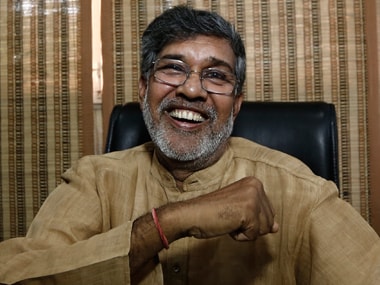Bhopal: Not many in India knew of Kailash Satyarthi until the Nobel committee dropped him into national consciousness. Even few knew of his organisation - Bachpan Bachao Andolan (BBA) until Friday. The low-profile, self-effacing Kailash preferred things to remain that way. He wanted his movement and the work to be known, not him as an individual. For someone who has been in public life for more than four decades, sustaining the relentless struggle for the cause close to his heart even at the risk to his own life, this is unique. [caption id=“attachment_1752047” align=“alignleft” width=“380”]  Kailash Satyarthi did his schooling in Vidisha, Madhya Pradesh. Reuters[/caption] Firstpost spoke to friends in his hometown Vidisha in Madhya Pradesh and learnt some interesting facts about the Nobel laureate’s life. He was not ‘Satyarthi’ to begin with. He was Kailash Sharma. The social activist, Swami Agnivesh, who brought ‘Stayarthi’ into the name after being impressed by the former’s total dedication to the cause of children. Born and brought up at Andar Kila locality in Vidisha, 50-km from state capital Bhopal, Satyarthi did his schooling in Vidisha and took admission in the government engineering college (SATI). However, instead of pursuing an engineering career, he opted to work for the rescue of bonded labourers along with Swami Agnivesh. “It was Swami Agnivesh, who named him as ‘Satyarthi’ after being impressed by his dedication towards the cause,” says Parthasarthy Dubey, a long time associate of Satyarthi and the state president of BBA from 1999-2007. Bhopal-based Dubey (54), an electrical engineer from Bangalore, too is a voluntary convert to the social sector. “I was then working with Association for Voluntary Action and later with the formation of BBA, we merged and started working with Satyarthi,” said Dubey. Satyarthi worked with Aginvesh for a decade, and later decided to work for the rescue of bonded child labourers, and that gave birth to the movement called Bachpan Bachao Andolan. Though he was working out of Delhi Dubey was in charge of Madhya Pradesh. According to those who had been associated with the movement since its inception, “the pitiful condition of child labourers who were deprived of everything in life including basic education disturbed Satyarthi a lot, and he decided that the evil of bonded child labourers needed to be addressed.” “I’ll not sit quiet till I free all children from bondage and who are dumped into slavery. I was moved for the first time when I was a primary school student in Vidisha after seeing a boy of my age polishing shoes outside my school. I then thought and asked my teacher why the boy should be deprived from going to school. I didn’t know what to do, but that was the beginning,” said the 60-year-old Satyarthi. There was hardly any awareness in the 1980s about child labour and we faced lots of criticism from people, said Dubey. It was difficult to convince the government and police about the menace. It was on a PIL in 1993 that the Supreme Court accepted our plea and it was established that if a child between the age of 6-14 years is not going to school, he must be engaged as labour somewhere,” he added. Dubey is now associated with the Right to Education movement. “Right to Education is also an outcome of this BBA,” he informed. Recalling his working with Satyarthi since 1990, Dubey says BBA with the help of the labour department conducted raids and rescued children working as bonded labourers. “The condition of children working in the slate industry was pathetic, as they got infected by silicosis and people died in their early 30s. Children were made to work in hazardous stone crushing units, lime kilns, Mica industry, Bidi factories etc across the country,” said Dubey. The BBA started three ashrams for these rescued children – one in Jaipur and one each for boys and girls in Delhi. Another initiative is its Bal Mitra Gram (BMG) programme, – model villages that are free of child exploitation and promote child- rights issues. Since the model’s inception in 2001, BBA has transformed 356 villages as child friendly villages across 11 states of India. Through this movement 80,000 children have been rescued till date. The children of these villages attend school, participate in Bal panchayat (child governance bodies), yuva mandals and mahila mandal and interact regularly with the gram panchayat. Many of these rescued children have now grown up to become engineers and other professionals, but they act as volunteers and go out in vans (Mukti-Carvaan) to rescue children working as bonded labourers, said a volunteer closely associated with BBA. Satyarthi organised the Global March Against Child Labor in the 1990s – dedicated to freeing the millions of children abused worldwide in a form of modern slavery. It started working in other countries under South Asia Coalition on Child Servitude. While the menace has reduced with growing awareness and legal protection in place, there’s a lot more to do. The government, labour department and the police have to be more sensitive towards the social evil, said Dubey, hoping the Nobel honour for Satyarthi would attract more attention to the issue.
Born and brought up at Andar Kila locality in Vidisha, 50-km from state capital Bhopal, Satyarthi did his schooling in Vidisha and took admission in the government engineering college (SATI).
Advertisement
End of Article


)

)
)
)
)
)
)
)
)



